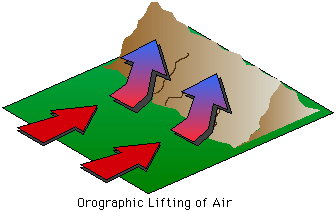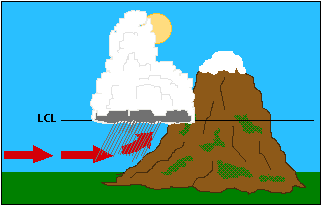Part 1:
A Review of Lifting Mechanisms in the Atmosphere
Even though the atmosphere at a given time may not be showing a
great
display of activity, you cannot be too sure that the atmosphere
is
stable. A bucket of water balanced on top of a slightly opened
door
(waiting for you to walk through) may appear to be stable.
However, with
just a small nudge you quickly understand how unstable that
bucket really
is. You can think of an unstable atmosphere in much the same way
as the
bucket balanced on the door. The term stable means that the
atmosphere is
in a state that is resistant to change. An unstable atmosphere
may be in
balance but not at all resistant to change. A little push in the
right
direction (in this case, up) may produce all the change necessary
to
sustain vertical motion, causing turbulent mixing and the
production of
storms. Here, we will review a few mechanisms which serve as
catalysts
that can bring about that change.
 When air in motion reaches a barrier that it cannot go through or
around,
it often goes over it. We see this in nature when air lifts over
a
mountain. This process of a parcel or layer of air rising as a
result of
the topography is referred to as orographic uplifting. If
you
remember from Session 3, the equation of state and Poisson's equation illustrate
the
relationship between the temperature and the pressure of an air
parcel.
As air lifts over a mountain, the pressure and temperature
decrease
according to the dry
adiabatic lapse rate until reaching the lifting condensation level (LCL).
Above the
LCL the temperature decreases according to the moist adiabatic
lapse
rate. If the temperature of the rising air decreases faster
than the
lapse rate of the air around it (the environmental lapse rate),
then the parcel will continue to rise
only as long as it is forced from below. A parcel of rising air
that
cools at a slower rate than the environmental lapse rate will
continue to
rise as a result of its buoyancy. We shall see a little later
that this
comparison of lapse rates is the process we use in determining
the
stability of the atmosphere. (Part 4: Stable, Neutral, and
Unstable
Atmospheres)
Click on the image below to view an animation of orographic lifting. Or, if you do not have a frames-compatible browser, you may follow this link to view the animation without frames.
When air in motion reaches a barrier that it cannot go through or
around,
it often goes over it. We see this in nature when air lifts over
a
mountain. This process of a parcel or layer of air rising as a
result of
the topography is referred to as orographic uplifting. If
you
remember from Session 3, the equation of state and Poisson's equation illustrate
the
relationship between the temperature and the pressure of an air
parcel.
As air lifts over a mountain, the pressure and temperature
decrease
according to the dry
adiabatic lapse rate until reaching the lifting condensation level (LCL).
Above the
LCL the temperature decreases according to the moist adiabatic
lapse
rate. If the temperature of the rising air decreases faster
than the
lapse rate of the air around it (the environmental lapse rate),
then the parcel will continue to rise
only as long as it is forced from below. A parcel of rising air
that
cools at a slower rate than the environmental lapse rate will
continue to
rise as a result of its buoyancy. We shall see a little later
that this
comparison of lapse rates is the process we use in determining
the
stability of the atmosphere. (Part 4: Stable, Neutral, and
Unstable
Atmospheres)
Click on the image below to view an animation of orographic lifting. Or, if you do not have a frames-compatible browser, you may follow this link to view the animation without frames.





Developed by
 The
Shodor
Education Foundation, Inc.
The
Shodor
Education Foundation, Inc.
Copyright © 1996
 When air in motion reaches a barrier that it cannot go through or
around,
it often goes over it. We see this in nature when air lifts over
a
mountain. This process of a parcel or layer of air rising as a
result of
the topography is referred to as orographic uplifting. If
you
remember from Session 3, the equation of state and Poisson's equation illustrate
the
relationship between the temperature and the pressure of an air
parcel.
As air lifts over a mountain, the pressure and temperature
decrease
according to the dry
adiabatic lapse rate until reaching the lifting condensation level (LCL).
Above the
LCL the temperature decreases according to the moist adiabatic
lapse
rate. If the temperature of the rising air decreases faster
than the
lapse rate of the air around it (the environmental lapse rate),
then the parcel will continue to rise
only as long as it is forced from below. A parcel of rising air
that
cools at a slower rate than the environmental lapse rate will
continue to
rise as a result of its buoyancy. We shall see a little later
that this
comparison of lapse rates is the process we use in determining
the
stability of the atmosphere. (Part 4: Stable, Neutral, and
Unstable
Atmospheres)
Click on the image below to view an animation of orographic lifting. Or, if you do not have a frames-compatible browser, you may follow this link to view the animation without frames.
When air in motion reaches a barrier that it cannot go through or
around,
it often goes over it. We see this in nature when air lifts over
a
mountain. This process of a parcel or layer of air rising as a
result of
the topography is referred to as orographic uplifting. If
you
remember from Session 3, the equation of state and Poisson's equation illustrate
the
relationship between the temperature and the pressure of an air
parcel.
As air lifts over a mountain, the pressure and temperature
decrease
according to the dry
adiabatic lapse rate until reaching the lifting condensation level (LCL).
Above the
LCL the temperature decreases according to the moist adiabatic
lapse
rate. If the temperature of the rising air decreases faster
than the
lapse rate of the air around it (the environmental lapse rate),
then the parcel will continue to rise
only as long as it is forced from below. A parcel of rising air
that
cools at a slower rate than the environmental lapse rate will
continue to
rise as a result of its buoyancy. We shall see a little later
that this
comparison of lapse rates is the process we use in determining
the
stability of the atmosphere. (Part 4: Stable, Neutral, and
Unstable
Atmospheres)
Click on the image below to view an animation of orographic lifting. Or, if you do not have a frames-compatible browser, you may follow this link to view the animation without frames.

 The
Shodor
Education Foundation, Inc.
The
Shodor
Education Foundation, Inc.